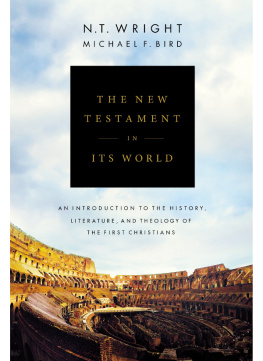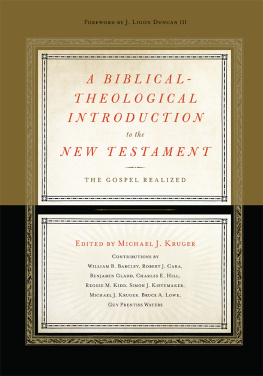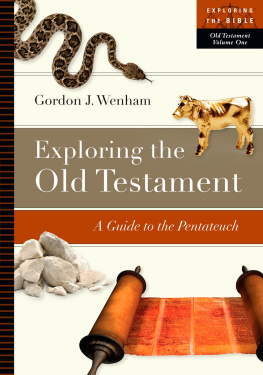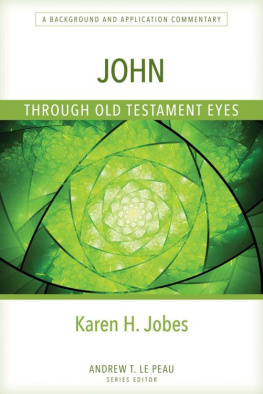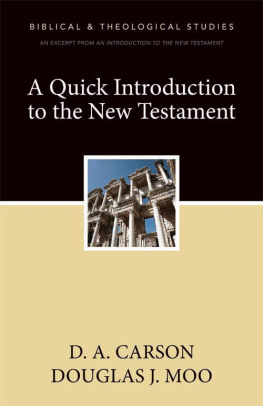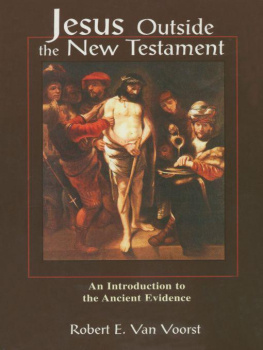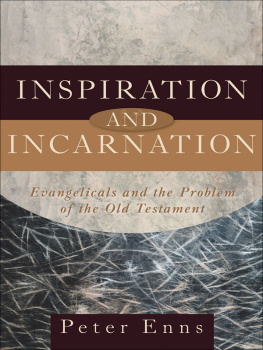AN INTRODUCTION TO THE NEW TESTAMENT
THE ANCHOR YALE BIBLE REFERENCE LIBRARY is designed to be a third major component of the Anchor Yale Bible group, which includes the Anchor Yale Bible commentaries on the books of the Old Testament, the New Testament, and the Apocrypha and the Anchor Yale Bible Dictionary. While the Anchor Yale Bible commentaries and the Anchor Yale Bible Dictionary are structurally defined by their subject matter, the Anchor Yale Bible Reference Library serves as a supplement on the cutting edge of the most recent scholarship. The series is open-ended; the scope and reach are nothing less than the biblical world in its totality, and its methods and techniques the most up-to-date available or devisable. Separate volumes will deal with one or more of the following topics relating to the Bible: anthropology, archaeology, ecology, economy, geography, history, languages and literatures, philosophy, religion(s), theology.
As with the Anchor Yale Bible commentaries and the Anchor Yale Bible Dictionary, the philosophy underlying the Anchor Yale Bible Reference Library finds expression in the following: the approach is scholarly, the perspective is balanced and fair-minded, the methods are scientific, and the goal is to inform and enlighten. Contributors are chosen on the basis of their scholarly skills and achievements, and they come from a variety of religious backgrounds and communities. The books in the Anchor Yale Bible Reference Library are intended for the broadest possible readership, ranging from world-class scholars, whose qualifications match those of the authors, to general readers, who may not have special training or skill in studying the Bible but are as enthusiastic as any dedicated professional in expanding their knowledge of the Bible and its world.
David Noel Freedman
GENERAL EDITOR
THE ANCHOR YALE BIBLE REFERENCE LIBRARY
AN INTRODUCTION
TO
THE NEW TESTAMENT
BY
Raymond E. Brown, S.S.

First published in 1997 by Doubleday, a division of Random House, Inc.
First Yale University Press impression 2010.
Copyright 1997 by The Associated Sulpicians of the U.S.
The Anchor Yale logo is a trademark of Yale University.
All rights reserved.
This book may not be reproduced, in whole or in part, including illustrations, in any form (beyond that copying permitted by Sections 107 and 108 of the U.S. Copyright Law and except by reviewers for the public press), without written permission from the publishers.
Printed in the United States of America.
Library of Congress Cataloging-in-Publication Data
Brown, Raymond Edward.
An introduction to the New Testament / by Raymond E. Brown.1st ed.
p. cm(The Anchor Bible reference library)
Includes bibliographical references and index.
1. Bible. N.T.Introductions. 2. Bible. N.T. Theology. 3. Bible. N.T.Canon.
I. Title. II. Series.
BS2330.2.B76 1997
225.6'1dc21 96-37742
CIP
Nihil obstat
Myles M. Bourke, S.T.D., S.S.L.
Censor deputatus
Imprimatur
Patrick J. Sheridan, D.D.
Vicar General, Archdiocese of New York
November 19, 1996
The nihil obstat and imprimatur are official declarations that a book or pamphlet is free of doctrinal or moral error. No implication is contained therein that those who have granted the nihil obstat and imprimatur agree with the contents, opinions, or statements expressed.
ISBN 978-0-300-14016-3 (hardcover : alk. paper)
A catalogue record for this book is available from the British Library.
This paper meets the requirements of ANSI/NISO Z39.48-1992
(Permanence of Paper).
To
a remarkable group of doctoral candidates
who studied at Union Theological Seminary (NYC)
in the years J. Louis Martyn and I taught New Testament
and who now teach me by their writings
FOREWORD AND ACKNOWLEDGMENTS
The Goal of this Volume
Though the title An Introduction to the New Testament would seem to explain the purpose of this volume, a number of clarifications are necessary for readers to know what is intended.
First, the readership that is envisioned has implications. This book is introductory, and therefore not written for fellow scholars. I envision both readers who have become interested in the NT on their own and readers who take NT beginning courses on different levels (e.g., Bible study groups, religious education, college surveys, and initial seminary classes). As part of a Reference Library series, the book must also supply inquirers with general information on the NT. In other words I have attempted a book that the first time one reads intensively parts of the NT can give guidance and later help to answer more specific questions. The envisioned goal and readership has led to the following decisions:
Readers of the NT who know Greek, the language in which it was written, can make their own informed efforts to grasp what the authors were trying to communicate. Without a knowledge of Greek, plays on words are often lost; moreover some basic concepts of NT theology (e.g., koinnia) defy adequate translation. Nevertheless, the purpose of this Introduction is to encourage, not to discourage. The vast majority of the readers envisioned will not know Greek; but they may be assured that with English as the only linguistic tool, it is possible to have a good knowledge of the Scriptures, even if not a professional one.
Only bibliography in English will be cited because those addressed will probably not be able to consult biblical research in foreign languages. Significant ideas from that important scholarship will enter the discussion but without references to works not translated.
Because this Introduction is to be used in courses at different levels (in some of which readings or papers will be assigned) the contents of the bibliographies will vary. For example, they will list both elementary and more detailed studies, short and lengthy commentaries.
The bibliographies will favor books over journal articles because books are more likely to be available to the general reader. They will also favor more recent literature, although classics from an earlier period will be noted.
Second, this book concentrates on the New Testament, not on Early Christianity. Why? The study of early Christianity moves into church history and so is a much wider field than biblical research. Only in a limited way is Christianity a religion of the book. Those who followed and proclaimed Christ existed for some twenty years before a single NT book was written (i.e., before AD 50). Even when the NT books were being composed (ca. AD 50150), Christian communities existed in areas where no preserved book was authored; and surely they had ideas and beliefs not recorded in any NT book. (Indeed some who thought of themselves as followers of Christ probably had ideas rejected or condemned by NT writers.) Furthermore, during the last few decades in which NT books were being penned, Christians were producing other preserved writings (e.g., Didache, I Clement, Epistles of Ignatius of Antioch, Gospel of Peter, Protevangelium of James). While I shall mention those works where appropriate and give brief background for them in Moreover, these books exist, and in that sense are more certain than conjectural, undocumented, or sparsely documented reconstructions of early Christianity.
Let me supply a specific illustration of the approach taken in this Introduction. Many readers of the NT want to know what Jesus was like, what he thought of himself, and what he said precisely; but here the issue of the historical Jesus will be treated only in below.
Next page

